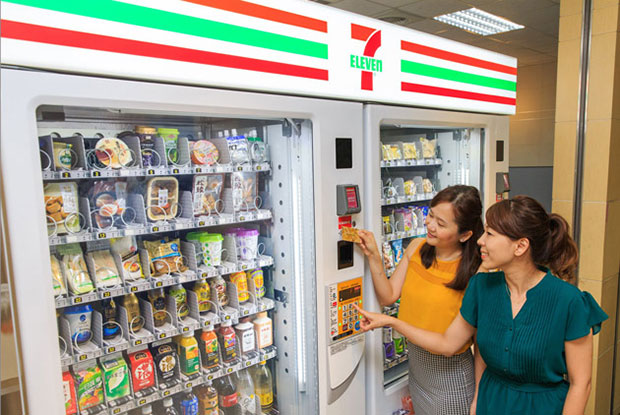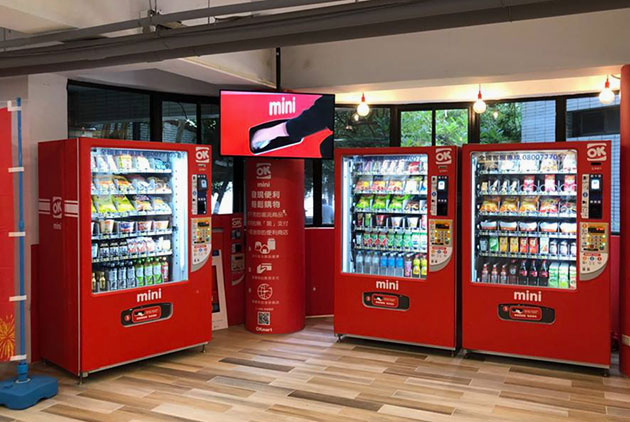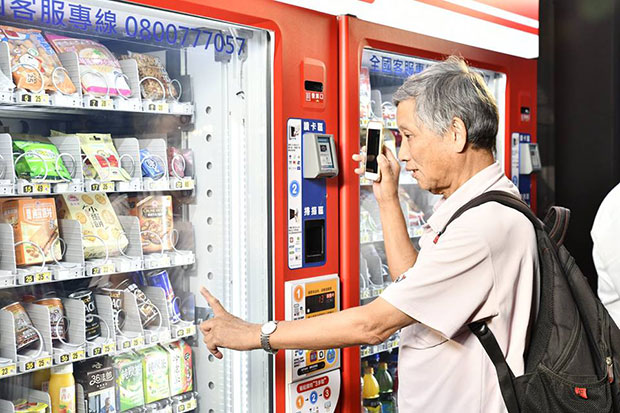From Unmanned Stores to Smart Vending Machines
Taiwan's Next Convenience Store Battlefield?

Source:7-Eleven
Last year, convenience store chains in Taiwan were entirely focused on unmanned stores. But this March, 7-Eleven surprisingly shelved plans for an expanding network of unmanned stores as the industry opens another battle front earlier than expected: smart vending machines. Do such machines constitute a successful solution, or are they only a temporary substitute until truly fully automated, unmanned shops become reality?
Views
Taiwan's Next Convenience Store Battlefield?
By Yi-chih Wangweb only
If last year’s hottest catchword in the financial industry was “fintech” (short for financial technology), this year it is “online banking.”
If we apply the same logic to the convenience store sector in Taiwan, which boasts the second-highest store density in the world, then last year’s industry focus was on “unmanned stores.” Yet market predictions have it that we will see an about-face this year as the new battle over “smart vending machines” is on.
The dramatic reorientation was triggered by a change of mind at the top echelons of industry bellwether 7-Eleven.
Like Japan, Taiwan faces severe manpower shortages due to a low birthrate. On top of that, the introduction of new five-day workweek rules in 2017 and minimum wage hikes have led to higher labor costs. In late January of 2018, trailblazer 7-Eleven shocked the retail industry with the opening of an unmanned “X-Store” that it touted as the convenience store of the future.
 Source: Screen capture of YouTube video
Source: Screen capture of YouTube video
Aside from the sector’s No. 2 FamilyMart, which already had another strategy in place, the other convenience store chains were caught off guard and racked their brains as to how to employ high-tech solutions to keep up with the pace of unmanned stores and automation. FamilyMart, for its part, said that instead of going for unmanned stores, it would introduce a dozen new technologies in selected “tech stores” to reduce the workload of store personnel.
“Each time before the boss calls a board meeting, he wants us to brainstorm approaches regarding unmanned stores, or else he won’t be able to give explanations,” remarks an upper management supervisor, shaking his head.
 The FamilyMart concept stores launched last year emphasize the smart use of digital technology to reduce the workload of store employees. The paper-based price tags on store shelves have been replaced by electronic labels that can be easily updated. Consumers can scan the QR Code with their mobile devices to view detailed product information.
The FamilyMart concept stores launched last year emphasize the smart use of digital technology to reduce the workload of store employees. The paper-based price tags on store shelves have been replaced by electronic labels that can be easily updated. Consumers can scan the QR Code with their mobile devices to view detailed product information.
No one expected that pioneer 7-Eleven would suddenly roll back its unmanned store offensive within less than a year of launching it.
Failure of Unmanned Stores Sets Stage for Smart Vending Machine Rollout
President Chain Store Corporation General Manager Huang Jui-tien, who initially also headed the unmanned store taskforce, stunned reporters in March when he announced that the company would temporarily shelve the planned expansion of unmanned X-Stores.
One industry peer says in private that the two unmanned X-Stores launched in 2018 alone required a backup staff of eight people, which is far more than manned X-Stores require. He cited as reasons for needing the extra personnel the complex entry authentication measures, self-checkout hiccups, consumers who hesitate to step into unmanned stores, and the need for human beings to talk customers through processes and rearrange disorganized shelf displays.
However, industry insiders generally believe the expansion plan was shelved because the construction costs are too high for the investment to ever be recouped, and that the popularization of such stores is not feasible.
But Huang is optimistic about the prospect of automated vending machines with Internet of Things (IoT) functionality, which the company introduced in a pilot scheme in late last June.
Huang believes that such smart vending machines can fill voids that 7-Eleven stores cannot fill, be it timewise or space-wise. Therefore, Huang decided to temporarily change strategy to push smart vending machines, increasing their number from the current 30 to 500 machines before year-end.
“The remarks by the leading convenience store operator have prematurely opened a new battlefront for convenience stores over smart vending machines,” notes Samuel Yang, a section chief within the Hi-Life E-Commerce Department.
Taiwan’s fourth-largest convenience store chain OK Mart, which has only 880 outlets, had already announced the opening of “OK Mini” mini-shops with smart vending machines in June of 2018, months before Huang revealed that 7-Eleven was planning to quickly deploy such machines.
 Source: OK Mart
Source: OK Mart
The OK Mini vending machines accept 20 different cashless payment methods, issue uniform invoice receipts and provide products at three different storage temperatures. The current 300 vending machines will be increased to a target of 1,000 by the end of the year.
“We intend to rely on smart vending machines to achieve maximum results with minimum effort, to bet on a possible victory,“ says Chan Hsing-sheng, manager with OK Mart’s Office of General Planning.
 OK Mart launched its “OK Mini” mini-shops last summer, taking the lead in introducing smart vending machines. The company expects to deploy up to 1,000 machines by the year’s end. (Source: OK Mart)
OK Mart launched its “OK Mini” mini-shops last summer, taking the lead in introducing smart vending machines. The company expects to deploy up to 1,000 machines by the year’s end. (Source: OK Mart)
Hi-Life, which has twice as many stores as OK Mart, is not to be outdone. In late March, the company set up three “HiStore” vending machines at the B2 level of Taipei City Hall to test the market. They also put up a vending machine with a large touch screen in preparation for a large offensive based on machine-consumer interaction.
Yang explains that consumers will obtain coupons and customer loyalty points when they interact with smart vending machines. These can be taken to traditional convenience stores in exchange for cash discounts and add-on items.
“We want to create a virtuous cycle and not interrupt consumption.”
Even FamilyMart, which has been tight-lipped about smart vending machines, is diligently working toward a rollout in private. A vending machine sales manager reveals that FamilyMart’s smart vending machine are currently in the testing stage, and are expected to make their debut in the middle of the year if everything goes according to plan.
Vending Machines Crucial to Convenience Store Strategy
It is hard to imagine how the rectangular vending machines, which have been around almost 50 years and occupy less than two square meters of floor space, could overnight gain such a crucial role in the convenience store sector’s market strategy. Now they are even seen as setting the future trend for the retail industry.
There are four reasons behind this development.
First, smart vending machines help solve manpower shortages, but they are cheaper than unmanned stores and seen as more down-to-earth.
TenLife Corporation Chairman Chen Lai-juh, a former AU Optronics Corp. president, observes that between late 2017 and 2018, the global retail industry exclusively focused on unmanned stores as the epitome of new automated retail. But given his background in the high-tech industry, Chen believes that these technologies are not yet mature. Since a host of problems still needs to be overcome, and such unmanned stores require investment on the order of tens of millions if not hundreds of millions of New Taiwan dollars, rollouts on a large scale are very difficult.
“Introducing unmanned technologies is not wrong, but it is too early and to expensive. You need to spend only US$10,000 on a smart vending machine that can act as a miniature version of the O2O (online to offline) business model,” says Chen, who, spotting the trend, had already entered the market two years ago. Meanwhile, his company has made itself a name in Taiwan as a provider of integrated smart vending machine systems.
Smart vending machines also constitute an opportunity for convenience stores operators to explore new directions and possibilities in an otherwise saturated market.
With one convenience store per every 2,300 people, Taiwan boasts the second-largest store density in the world, behind South Korea. But in recent years, outlet net growth has slowed to single-digit rates. Given rising rents and labor costs, on top of a shrinking demographic dividend, unfettered store growth is a thing of the past.
In Japan, 4.8 million vending machines complement the 55,000 convenience stores across the nation. There is virtually nothing that cannot be bought from a machine, be it freshly boiled ramen noodle soup, raw eggs or even live pets.
Moreover, the cost of installing smart vending machines and the population needed to support them is markedly lower than that for convenience stores. While it takes 2,500 people to make a convenience store economically viable, just 200 people can support a smart vending machine, which costs just one tenth of a store.
Instantly Meeting Demand by Integrating Vending Machines With IoT
Most important for operators is the fact that “intelligent” smart technologies can solve the inconveniences associated with traditional vending machines.
Once traditional vending machines are hooked up to the Internet of Things, they can immediately provide three new functions: First, they can accept all kinds of payment cards or mobile payments. Second, the storage temperature for the goods inside the vending machines can be controlled at different levels, and third, sales and inventory can be managed remotely via apps. Again, the collected sales data can be analyzed to predict future sales.
Have you read?
♦ Taiwanese AI Gives ‘Smart Vision’ for Australian Supermarket Chains
♦ What’s the Scoop on “Brick and Mortar E-commerce?”
♦ Liquid Snacks? The Rationale Behind Milk Drinks with Snack Flavors
According to TenLife research, 27 percent of complaints about vending machines are related to coins. Machines might not accept coins when the internal cash box is full, customers might insert fake coins or tokens, the cash box might be damaged, and counting the cash costs time, money and manpower. With cashless payments, such problems can all be eliminated for good.
So, what kind of goods can be sold via smart vending machines? “It’s like a mini convenience store: mainly beverages, fresh food and snacks. The selection covers 70 percent of the entire product range but does not offer as much variety,” explains OK Mart’s Chan. Compared to convenience stores, smart vending machines need to meet customer demand even more immediately.
Yang reveals that the vending machines are primarily filled with the top-selling products for a respective locality. Adjustments are then based on the actual sales. Presently, vending machine with freezing and heating technology are being developed so that frozen meals can be heated up inside the machine at the time of purchase. “The microbe count in packed hot meals rises very quickly after 45 minutes; that’s why you can’t sell them via smart vending machines.”
In the past, controlling and restocking vending machines accounted for the lion’s share of operators’ expenses. With rising gasoline prices and the implementation of new five-day workweek rules, costs kept rising.
Big Data Biggest Plus of Smart Vending Machines
Presently, the three convenience store chains that have rolled out smart vending machines run them as affiliates of a nearby convenience store. This means that the store manager controls restocking and accounting. Thanks to this model, costs can be reduced, and the product lineup can be adjusted at any time if the situation requires it.
In areas that are off limits for the general public, such as office buildings, schools, factories or military premises, the vending machines can be controlled remotely via an app. Since the sales and stocking situation can be monitored in real time, it is no longer necessary to dispatch fully loaded delivery trucks for a whole day of routine checking and restocking. As a result, costs are expected to fall by 30 percent.
The app also allows the influence of sales at opportune times, for instance through special offers for products that have not yet sold out, to boost restocking efficiency. At the same time, such campaigns can boost sales by 5 to 8 percent.
Chen describes smart vending machines as “third-generation automated vending machines.” The biggest advantage of using them lies in the massive transformation, the brand-new business model and the data that the combination of money, product and information flows generate.
Backed up by data, store operators can flexibly adjust the product selection and boost sales. Chen expects even greater benefits from using data to design matching marketing campaigns. When the data-driven algorithm concludes that a certain customer always buys a yogurt drink from a certain vending machine on Wednesdays, then a special sales campaign can be launched on Wednesdays, which will naturally increase the probability of a purchase by that customer.
A special feature of smart vending machines is that they come with a touchscreen that makes it possible to carry out multiple application management services via multiple screens across one cloud network.
“Multiple screens means mobile phones, tablets and the like,” explains Chen.
If too many people want to interact with the smart vending machine, you won’t have to wait in line in the scorching sun. Instead, you can take out your mobile phone and interact with the smart vending machine by playing a game. The resulting QR Code could then be exchanged for a gift at a convenience store.
Smart Vending Machines – Solution or Stopgap?
However, current smart vending machines are not yet able to interact with consumers. And they are much less able to collect big data to build strong algorithms.
“The smart vending machines used by the three major convenience stores are still traditional ones; it’s just that they have been fitted with a payment module,” notes Li Shyh-jane, vice director of the Business Model Innovation Research Division at the Commerce Development Research Institute, hitting the nail right on the head.
Businesses from other fields such as cake brands or lunchbox vendors who began to introduce smart vending machines last year are apparently not able to capitalize on application data.
While the convenience store chains are scrambling to jump onto the smart vending machine trend, they are actually still testing the waters and looking for the best business model.
Retail guru Hsu Chung-jen, the former president of supermarket chain PX Mart, believes that we will have to rely on smart vending machines in the near future. (Read: PX Mart Opens 1000th Store, What's the Scoop?) Just like Japan, he predicts, Taiwan will one day face such severe manpower shortages that manned convenience stores cannot stay open round the clock anymore. Then fully automated smart vending machines that work, rain or shine, will have to provide us with convenient services.
Li still anticipates that, once smart vending machines are truly automated, unmanned stores will see the light of day.
“Smart vending machines are only a stopgap, an alternative as everyone waits for the best solution,” he predicts.
Whether unmanned vending machines with smart functions, be it as a final solution or a stopgap, can successfully transform retailing, depends on the creation of a unique consumer experience.
Translated by Susanne Ganz
Edited by Sharon Tseng







